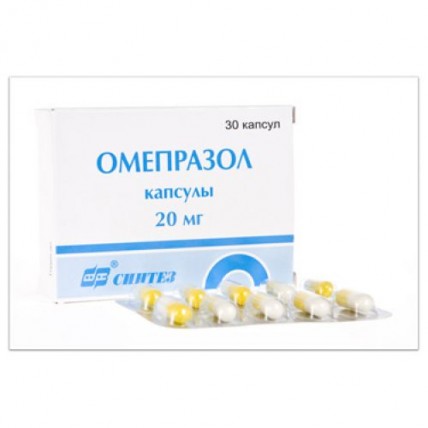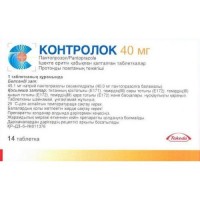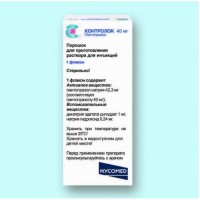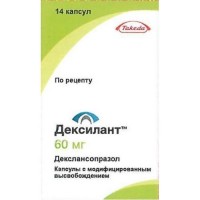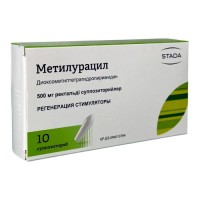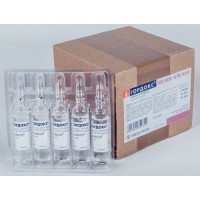The instruction
for medical use
of OMEPRAZOLUM medicine
the Trade name
OMEPRAZOLUM
the International unlicensed
name Omeprazolum Dosage Form
of the Capsule, 20 mg
Structure
One capsule contains
active agent – omeprazolum (pellets) the containing omeprazolum of 20 mg,
excipients of pellets: calcium carbonate, potassium hydrophosphate, gipromelloza, Mannitolum, sugar krupka, sugar syrup, macrogoal-6000, povidone-K30, sodium hydroxide, sodium lauryl sulfate, talc, titan dioxide (E171), polysorbate-80
structure of a cover of pellets: methacrylic acid and ethyl acrylate copolymer,
structure of the body of the capsule: titan dioxide (E171), gelatin,
structure of a lid of the capsule: the titan dioxide (E171), yellow quinolinic (E104), yellow Sunset (E110), gelatin
the Description
Gelatin capsules No. 2 with the white body, a yellow cover. Contents of capsules – white or almost white pellets of spherical shape
Pharmacotherapeutic group
Drugs for treatment of the diseases connected with disturbance of acidity. The antiulcerous drugs and drugs used for treatment of a gastroesophageal reflux. Inhibitors of the protonew pump. Omeprazolum
the ATX A02BC01 Code
the Pharmacological
Pharmacokinetics Later properties of administration of drug inside omeprazolum is quickly absorbed from digestive tract, the maximum concentration in plasma is reached in 0.5-1 hour. The bioavailability is 30-40%. Linking with proteins of plasma – 90-95%.
Omeprazolum biotransformirutsya almost completely in a liver with education 6 pharmacological of inactive metabolites (hydroxyomeprazolum, sulphidic and sulfonic derivatives). It is removed generally by kidneys (70-80%) and with bile (20-30%) in the form of metabolites.
The pharmacokinetics in special clinical cases
In chronic kidney disease removal decreases in proportion to decrease in clearance of creatinine. At elderly people the removal of omeprazolum decreases, the bioavailability increases. In a liver failure the bioavailability increases up to 100%, elimination half-life – 2-3 hours.
A pharmacodynamics
Omeprazolum – antiulcerous drug, inhibitor of H+/K+ enzyme - adenosine triphosphate (ATP) - phases. Brakes activity of H+/K+ - adenosine triphosphate (ATP) - phases (N +/K+ - adenosine triphosphate (ATP) - phases, it – the proton pump or the protonew pump) in covering cells of a stomach, thereby blocks transfer of ions of hydrogen and a final stage of synthesis of hydrochloric acid in a stomach. Omeprazolum is pro-medicine. In acidic environment of tubules of covering cells omeprazolum turns into an active metabolite sulphenamide which inhibits membrane H+/K+ - adenosine triphosphate (ATP) - phases, connecting to it at the expense of the disulfide bridge. The sharp selectivity of effect of omeprazolum on covering cells where there is an environment for formation of sulphenamide is explained by it. Omeprazolum biotransformation in sulphenamide occurs quickly (in 2-4 min.). Sulphenamide is a cation and is not exposed to absorption.
Omeprazolum suppresses basal and stimulated any irritant secretion of hydrochloric acid at a final stage. Reduces the total amount of gastric secretion and pepsin discharge oppresses.
The Omeprazolum capsules contain microgranules, coated, gradual release and the beginning of effect of omeprazolum begins in 1 hour after reception, reaches a maximum in 2 hours, remains within 24 hours and more. The inhibition of 50% of the maximum secretion after single dose of 20 mg of drug proceeds 24 hours.
Single dose in day provides the fast and effective oppression of day and night gastric secretion reaching the maximum in 4 days of treatment. At patients with a peptic ulcer of a duodenum the reception of 20 mg of omeprazolum supports rn 3 in a stomach within 17 hours. After the termination of administration of drug the secretory activity is completely restored in 3-5 days.
Indications
- a peptic ulcer of a stomach and duodenum (in a phase of aggravation and antirecurrent treatment), including. associated with Helicobacter pylori (as a part of combination therapy)
- a reflux esophagitis (including erosive)
- the erosive cankers of a stomach and duodenum connected with intake of non-steroidal anti-inflammatory drugs
- hyper secretory states (Zollingera-Ellison's syndrome, stressful ulcers of digestive tract, polyendocrine adenomatosis, a system mastocytosis)
the Route of administration and doses
Inside, capsules usually accept in the morning, without chewing, washing down with a small amount of water (just before food).
A peptic ulcer of a duodenum in an aggravation phase: 20 mg (1 caps) / days within 2-4 weeks, in resistant cases - up to 40 mg (2 caps / days).
A peptic ulcer of a stomach in a phase of aggravation and an erosive and ulcer esophagitis: 20-40 mg (1-2 caps) / days within 4-8 weeks.
The GIT erosive cankers caused by intake of non-steroidal anti-inflammatory drugs: 20 mg (1 caps) / days within 4-8 weeks.
Eradikation Helicobacter pylori: on 20 mg (1 caps) 2 times/days within 7 days in combination with antibacterial agents.
Antirecurrent treatment of a peptic ulcer of a stomach and duodenum: 20 mg (1 caps) / days.
Antirecurrent treatment reflux esophagitis: 20 mg (1 caps) / days for a long time (up to 6 months).
Zollingera-Ellison's syndrome: the dose is selected individually depending on the initial level of gastric secretion, usually since 60 mg/days. If necessary the dose is increased to 80-120 mg/days, in this case it is divided into 2 receptions.
In special situations. In a liver failure appoint 10-20 mg (1 caps / days), in a heavy liver failure the daily dose should not exceed 20 mg, in a renal failure and it is not required from elderly patients of correction of the mode of dosing.
Side effects
Often
- a headache, dizziness at patients with the serious accompanying somatopathies
Sometimes
- diarrhea or constipations, an abdominal pain, nausea, vomiting, a meteorism
- increase in body weight, a hypoglycemia, a hyponatremia
- a purpura, petechias, xeroderma, a hair loss
- sonitus, a food faddism, moderate disturbances of visual and hearing
- a leukopenia, thrombocytopenia, an agranulocytosis, a pancytopenia
- sweating strengthening, peripheral hypostases
- increase in arterial blood pressure
- allergic reactions – skin rash and/or an itching, a small tortoiseshell, a Quincke's disease, fever, a bronchospasm, interstitial nephrite and an acute anaphylaxis
Seldom
- increase in activity of hepatic enzymes, disturbances of taste
- excitement, a depression, at patients with the previous serious illness of a liver are encephalopathy
- a disorder of vision
- an indisposition
- a gynecomastia
- formation of gastric glandulyarny cysts during long-term treatment (a consequence of inhibition of secretion of hydrochloric acid, has benign, reversible character)
- stenocardia, tachycardia, bradycardia, heartbeat, a vasculitis
Very seldom
- dryness in a mouth, stomatitis, patients with the previous serious illness of a liver have hepatitis (including with jaundice), an abnormal liver function, pancreatitis, anorexia, irritation of a large intestine, discoloration a calla, esophageal candidiasis
- an arthralgia, a myasthenia, myalgia
- a photosensitization, a multiformny exudative erythema, an alopecia, Stephens-Johnson's syndrome and a toxic necrolysis of epidermis
- risk of developing spinal fractures, necks of a hip,
the Contraindication wrist
- hypersensitivity to drug
- children's and teenage age up to 18 years
- pregnancy and the period of a lactation
With care: renal and/or liver failure.
Medicinal interactions
Omeprazolum can reduce absorption of ethers of ampicillin, salts of iron, an itrakonazol and ketokonazol (omeprazolum raises rn a stomach).
Being P450 cytochrome inhibitor, can increase concentration and reduce removal of diazepam, anticoagulants of indirect action, Phenytoinum (medicines which are metabolized in a liver by means of CYP2C19 cytochrome) that in certain cases can demand reduction of doses of these medicines. Can increase concentration of a klaritromitsin in blood plasma.
At the same time prolonged use of omeprazolum in a dose of 20 mg of 1 times a day in a combination with caffeine, theophylline, piroxicam, diclofenac, Naproxenum, metoprololy, propranolol, ethanol, cyclosporine, lidocaine, quinidine and oestradiol did not lead to change of their concentration in plasma.
Strengthens inhibiting effect on the system of a hemopoiesis and other medicines.
Interaction with at the same time accepted antacids is noted.
Special instructions
before therapy it is necessary to exclude existence of malignant process (especially in stomach ulcer) as treatment, masking symptomatology, can delay production of the correct diagnosis.
Reception along with food does not affect its efficiency.
The diagnosis a reflux esophagitis has to be confirmed endoscopic.
It must be kept in mind that Omeprazolum, reducing acidity of gastric juice, can promote the increased risk of developing salmonellosis and campylobacteriosis.
At patients with abnormal liver functions, kidneys and also at prolonged use (over 1 year) of drug it is necessary to carry out monitoring of transaminases, creatinine regularly. At disorder of vision and hearing it is regularly necessary to hold testing to and during drug use.
Features of influence of medicine on ability to run the vehicle or potentially dangerous mechanisms
Considering side effects of drug, it is necessary to be careful at control of motor transport or other potentially dangerous mechanisms.
Overdose
Symptoms: confusion of consciousness, illegibility of sight, drowsiness, dryness in a mouth, nausea, tachycardia, arrhythmia, a headache.
Treatment: symptomatic. There is no specific antidote.
A form of release and packing
On 10 capsules in blister strip packaging from a film of polyvinylchloride and aluminum foil.
3 blister strip packagings with the instruction for medical use in the state and Russian languages place in a pack from cardboard.
To Store storage conditions in the dry, protected from light place at a temperature not over 25 ºС
to Store out of children's reach!
3 years
not to use a period of storage after an expiration date.
Prescription status
According to the prescription
JSC Sintez Producer.
Russia, 640008, Kurgan, Konstitutsii Avenue, 7
Ph./fax (3522) 48-16-89
E-mail: real@kurgansintez.ru
Website: http://www.kurgansintez.ru
the Owner of the registration certificate
of JSC Sintez, the Russian Federation
the Address of the organization accepting in the territory of the Republic of Kazakhstan claims from consumers on quality of products
of STOFARM LLP,
000100, Republic of Kazakhstan, Kostanay region, Kostanay, Uralskaya St., 14
ph. 714 228 01 79
To develop
for medical use
of OMEPRAZOLUM medicine
the Trade name
OMEPRAZOLUM
the International unlicensed
name Omeprazolum Dosage Form
of the Capsule, 20 mg
Structure
One capsule contains
active agent – omeprazolum (pellets) the containing omeprazolum of 20 mg,
excipients of pellets: calcium carbonate, potassium hydrophosphate, gipromelloza, Mannitolum, sugar krupka, sugar syrup, macrogoal-6000, povidone-K30, sodium hydroxide, sodium lauryl sulfate, talc, titan dioxide (E171), polysorbate-80
structure of a cover of pellets: methacrylic acid and ethyl acrylate copolymer,
structure of the body of the capsule: titan dioxide (E171), gelatin,
structure of a lid of the capsule: the titan dioxide (E171), yellow quinolinic (E104), yellow Sunset (E110), gelatin
the Description
Gelatin capsules No. 2 with the white body, a yellow cover. Contents of capsules – white or almost white pellets of spherical shape
Pharmacotherapeutic group
Drugs for treatment of the diseases connected with disturbance of acidity. The antiulcerous drugs and drugs used for treatment of a gastroesophageal reflux. Inhibitors of the protonew pump. Omeprazolum
the ATX A02BC01 Code
the Pharmacological
Pharmacokinetics Later properties of administration of drug inside omeprazolum is quickly absorbed from digestive tract, the maximum concentration in plasma is reached in 0.5-1 hour. The bioavailability is 30-40%. Linking with proteins of plasma – 90-95%.
Omeprazolum biotransformirutsya almost completely in a liver with education 6 pharmacological of inactive metabolites (hydroxyomeprazolum, sulphidic and sulfonic derivatives). It is removed generally by kidneys (70-80%) and with bile (20-30%) in the form of metabolites.
The pharmacokinetics in special clinical cases
In chronic kidney disease removal decreases in proportion to decrease in clearance of creatinine. At elderly people the removal of omeprazolum decreases, the bioavailability increases. In a liver failure the bioavailability increases up to 100%, elimination half-life – 2-3 hours.
A pharmacodynamics
Omeprazolum – antiulcerous drug, inhibitor of H+/K+ enzyme - adenosine triphosphate (ATP) - phases. Brakes activity of H+/K+ - adenosine triphosphate (ATP) - phases (N +/K+ - adenosine triphosphate (ATP) - phases, it – the proton pump or the protonew pump) in covering cells of a stomach, thereby blocks transfer of ions of hydrogen and a final stage of synthesis of hydrochloric acid in a stomach. Omeprazolum is pro-medicine. In acidic environment of tubules of covering cells omeprazolum turns into an active metabolite sulphenamide which inhibits membrane H+/K+ - adenosine triphosphate (ATP) - phases, connecting to it at the expense of the disulfide bridge. The sharp selectivity of effect of omeprazolum on covering cells where there is an environment for formation of sulphenamide is explained by it. Omeprazolum biotransformation in sulphenamide occurs quickly (in 2-4 min.). Sulphenamide is a cation and is not exposed to absorption.
Omeprazolum suppresses basal and stimulated any irritant secretion of hydrochloric acid at a final stage. Reduces the total amount of gastric secretion and pepsin discharge oppresses.
The Omeprazolum capsules contain microgranules, coated, gradual release and the beginning of effect of omeprazolum begins in 1 hour after reception, reaches a maximum in 2 hours, remains within 24 hours and more. The inhibition of 50% of the maximum secretion after single dose of 20 mg of drug proceeds 24 hours.
Single dose in day provides the fast and effective oppression of day and night gastric secretion reaching the maximum in 4 days of treatment. At patients with a peptic ulcer of a duodenum the reception of 20 mg of omeprazolum supports rn 3 in a stomach within 17 hours. After the termination of administration of drug the secretory activity is completely restored in 3-5 days.
Indications
- a peptic ulcer of a stomach and duodenum (in a phase of aggravation and antirecurrent treatment), including. associated with Helicobacter pylori (as a part of combination therapy)
- a reflux esophagitis (including erosive)
- the erosive cankers of a stomach and duodenum connected with intake of non-steroidal anti-inflammatory drugs
- hyper secretory states (Zollingera-Ellison's syndrome, stressful ulcers of digestive tract, polyendocrine adenomatosis, a system mastocytosis)
the Route of administration and doses
Inside, capsules usually accept in the morning, without chewing, washing down with a small amount of water (just before food).
A peptic ulcer of a duodenum in an aggravation phase: 20 mg (1 caps) / days within 2-4 weeks, in resistant cases - up to 40 mg (2 caps / days).
A peptic ulcer of a stomach in a phase of aggravation and an erosive and ulcer esophagitis: 20-40 mg (1-2 caps) / days within 4-8 weeks.
The GIT erosive cankers caused by intake of non-steroidal anti-inflammatory drugs: 20 mg (1 caps) / days within 4-8 weeks.
Eradikation Helicobacter pylori: on 20 mg (1 caps) 2 times/days within 7 days in combination with antibacterial agents.
Antirecurrent treatment of a peptic ulcer of a stomach and duodenum: 20 mg (1 caps) / days.
Antirecurrent treatment reflux esophagitis: 20 mg (1 caps) / days for a long time (up to 6 months).
Zollingera-Ellison's syndrome: the dose is selected individually depending on the initial level of gastric secretion, usually since 60 mg/days. If necessary the dose is increased to 80-120 mg/days, in this case it is divided into 2 receptions.
In special situations. In a liver failure appoint 10-20 mg (1 caps / days), in a heavy liver failure the daily dose should not exceed 20 mg, in a renal failure and it is not required from elderly patients of correction of the mode of dosing.
Side effects
Often
- a headache, dizziness at patients with the serious accompanying somatopathies
Sometimes
- diarrhea or constipations, an abdominal pain, nausea, vomiting, a meteorism
- increase in body weight, a hypoglycemia, a hyponatremia
- a purpura, petechias, xeroderma, a hair loss
- sonitus, a food faddism, moderate disturbances of visual and hearing
- a leukopenia, thrombocytopenia, an agranulocytosis, a pancytopenia
- sweating strengthening, peripheral hypostases
- increase in arterial blood pressure
- allergic reactions – skin rash and/or an itching, a small tortoiseshell, a Quincke's disease, fever, a bronchospasm, interstitial nephrite and an acute anaphylaxis
Seldom
- increase in activity of hepatic enzymes, disturbances of taste
- excitement, a depression, at patients with the previous serious illness of a liver are encephalopathy
- a disorder of vision
- an indisposition
- a gynecomastia
- formation of gastric glandulyarny cysts during long-term treatment (a consequence of inhibition of secretion of hydrochloric acid, has benign, reversible character)
- stenocardia, tachycardia, bradycardia, heartbeat, a vasculitis
Very seldom
- dryness in a mouth, stomatitis, patients with the previous serious illness of a liver have hepatitis (including with jaundice), an abnormal liver function, pancreatitis, anorexia, irritation of a large intestine, discoloration a calla, esophageal candidiasis
- an arthralgia, a myasthenia, myalgia
- a photosensitization, a multiformny exudative erythema, an alopecia, Stephens-Johnson's syndrome and a toxic necrolysis of epidermis
- risk of developing spinal fractures, necks of a hip,
the Contraindication wrist
- hypersensitivity to drug
- children's and teenage age up to 18 years
- pregnancy and the period of a lactation
With care: renal and/or liver failure.
Medicinal interactions
Omeprazolum can reduce absorption of ethers of ampicillin, salts of iron, an itrakonazol and ketokonazol (omeprazolum raises rn a stomach).
Being P450 cytochrome inhibitor, can increase concentration and reduce removal of diazepam, anticoagulants of indirect action, Phenytoinum (medicines which are metabolized in a liver by means of CYP2C19 cytochrome) that in certain cases can demand reduction of doses of these medicines. Can increase concentration of a klaritromitsin in blood plasma.
At the same time prolonged use of omeprazolum in a dose of 20 mg of 1 times a day in a combination with caffeine, theophylline, piroxicam, diclofenac, Naproxenum, metoprololy, propranolol, ethanol, cyclosporine, lidocaine, quinidine and oestradiol did not lead to change of their concentration in plasma.
Strengthens inhibiting effect on the system of a hemopoiesis and other medicines.
Interaction with at the same time accepted antacids is noted.
Special instructions
before therapy it is necessary to exclude existence of malignant process (especially in stomach ulcer) as treatment, masking symptomatology, can delay production of the correct diagnosis.
Reception along with food does not affect its efficiency.
The diagnosis a reflux esophagitis has to be confirmed endoscopic.
It must be kept in mind that Omeprazolum, reducing acidity of gastric juice, can promote the increased risk of developing salmonellosis and campylobacteriosis.
At patients with abnormal liver functions, kidneys and also at prolonged use (over 1 year) of drug it is necessary to carry out monitoring of transaminases, creatinine regularly. At disorder of vision and hearing it is regularly necessary to hold testing to and during drug use.
Features of influence of medicine on ability to run the vehicle or potentially dangerous mechanisms
Considering side effects of drug, it is necessary to be careful at control of motor transport or other potentially dangerous mechanisms.
Overdose
Symptoms: confusion of consciousness, illegibility of sight, drowsiness, dryness in a mouth, nausea, tachycardia, arrhythmia, a headache.
Treatment: symptomatic. There is no specific antidote.
A form of release and packing
On 10 capsules in blister strip packaging from a film of polyvinylchloride and aluminum foil.
3 blister strip packagings with the instruction for medical use in the state and Russian languages place in a pack from cardboard.
To Store storage conditions in the dry, protected from light place at a temperature not over 25 ºС
to Store out of children's reach!
3 years
not to use a period of storage after an expiration date.
Prescription status
According to the prescription
JSC Sintez Producer.
Russia, 640008, Kurgan, Konstitutsii Avenue, 7
Ph./fax (3522) 48-16-89
E-mail: real@kurgansintez.ru
Website: http://www.kurgansintez.ru
the Owner of the registration certificate
of JSC Sintez, the Russian Federation
the Address of the organization accepting in the territory of the Republic of Kazakhstan claims from consumers on quality of products
of STOFARM LLP,
000100, Republic of Kazakhstan, Kostanay region, Kostanay, Uralskaya St., 14
ph. 714 228 01 79
To develop
